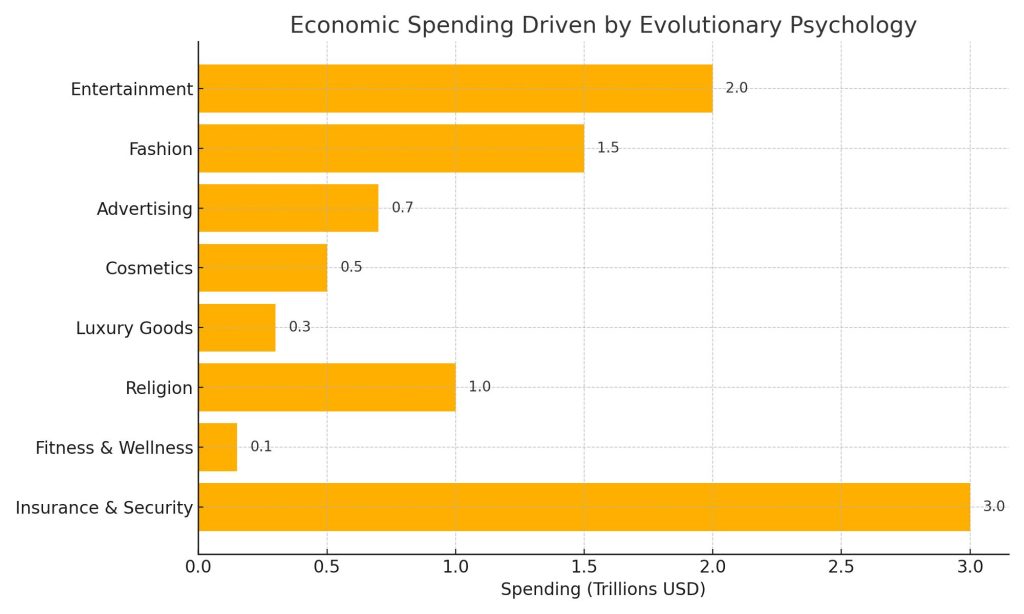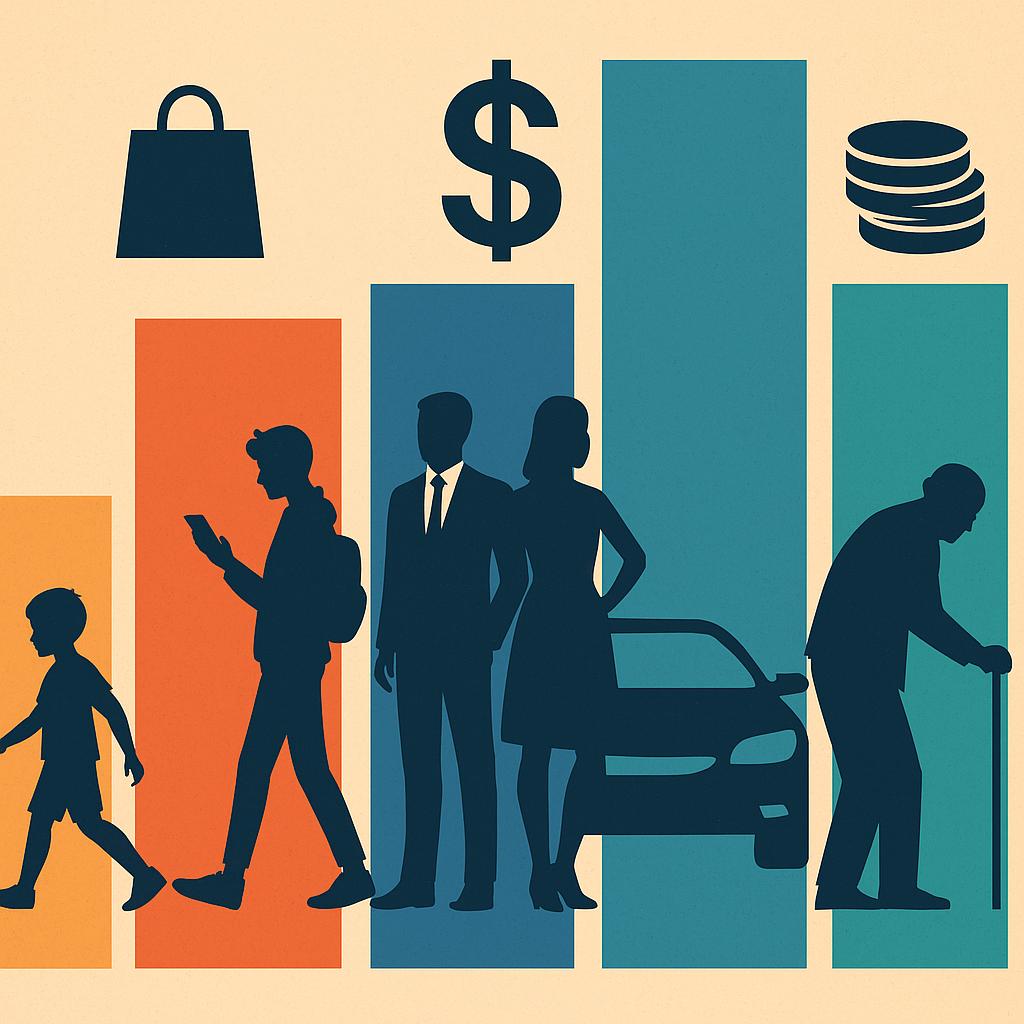Capitalism is not random. It is efficient because it adapts to what Homo sapiens already are, it evolves with our stages of life. And it responds to hormones, status drives, and survival instincts. It profits from mating rituals, fear of death, and longing for identity.
That is why it works. Capitalism is not separate from biology. It grows on it like a second skin. What you feel—it monetizes. What you lack—it sells.
From childhood to old age, it follows human nature as closely as any predator tracks prey.
The biological logic of human development
Humans do not live by seasons. They live by developmental phases. Evolution shaped each stage with a purpose. Childhood is for learning. Adolescence is for status and mating. Early adulthood is for risk-taking and competition. Maturity is for safety and kin investment. Old age is for passing on wisdom and enhancing inclusive fitness.
Each stage activates different psychological modules. These modules were shaped to solve different problems: find love, avoid exclusion, raise offspring, guard resources, manage status, seek meaning.
Capitalism targets each of them. It does not care why they evolved. It only asks: can it be sold?
Childhood – Play, imitation, and cognitive priming
Childhood is not a waiting room for adulthood. It is a full stage of evolved learning. It exists to simulate adulthood without fatal consequences. That is why play is central, that is why imitation is constant. That is why emotions run high. Evolution gave childhood as a safe space for the brain to test, bond, and remember.
During this phase, humans learn language, moral codes, group behavior, fairness, punishment, identity, and basic competence. It is the deepest foundation of all future behavior. And capitalism gets there first.
Capitalism fills childhood with brands, toys, sounds, screens, and characters. It creates entire worlds—Disney, Marvel, Barbie, Pokémon—where children attach emotionally to artificial signals. These are not innocent cartoons. They are identity-shaping products. They form emotional bonds before critical thinking develops.
Toys are adult proxies: kitchens, credit cards, medical kits, shopping carts, cash registers. Every form of adult social role becomes gamified. Children imitate status roles before they even understand them.
Screen-based content hijacks primal modules. Children are drawn to movement, sound, faces, and social interaction. Capitalism gives them algorithmic video loops that create emotional dependency. The longer they stay, the more profitable they become.
Even sugar is used. Bright packaging, cereal mascots, and fast food toys reinforce addiction circuits before the child knows what nutrition is. Dopamine systems are shaped before self-regulation can develop.
What the child learns is not logic—it is loyalty. Not truth, but repetition. These early pathways become the neural infrastructure for future consumption.
By age ten, many children can identify over 100 logos. They trust certain corporations more than they trust strangers. This is not education. It is emotional branding. Capitalism does not wait for adulthood. It imprints on the child before reason can interrupt.
Adolescence – Capitalism and mating displays
Adolescence is evolution’s starting gun for reproductive competition. Testosterone surges. Social comparison spikes. Every teenager becomes a tribal politician, mating strategist, and identity builder.
Capitalism knows what they need. It offers fashion, makeup, music, gadgets, fame, rebellion, and attention. It gives teenagers the tools to signal attractiveness, individuality, and dominance.
A sneaker is not footwear—it is a tribal badge. A phone is not communication—it is a portable hierarchy. Followers are not numbers—they are mating potential.
The adolescent brain is hypersocial, hyper-emotional, and hypersensitive to status. Evolution built it that way. Capitalism harvests every second of it.
Early adulthood – Conspicuous consumption and mate retention
Adulthood begins the performance. You must now attract, compete, provide, and bond. Evolution favors mating success, career building, risk tolerance, and long-term planning. Testosterone stays high. Ambition rises. Peer networks shift from exploration to alliance.
Capitalism meets this with incentives: career ladders, dating apps, entrepreneurship, gym culture, travel, and income signaling. Every product becomes an extension of your market value.
People buy what improves their sexual value: a degree, a car, a trip to Bali, a white smile, a tailored suit. Even “authenticity” becomes a purchasable trait—through minimalist design and curated aesthetics. Mate retention becomes a capitalist sub-economy.
Capitalism knows that fitness is not just biology. It is also narrative.
Maturity – Risk aversion and kin investment
With reproduction mostly complete, evolution shifts the goal: protect what you have. Secure your children. Stabilize your tribe. Plan for scarcity. The hormonal drive for novelty fades. Status becomes conservative.
So capitalism changes its tone. Now it sells insurance, home equity, safety features, retirement packages, and elite education for children. Consumption becomes less about self-expression, more about strategy.
Middle-aged people worry about health, crime, debt, and legacy. So brands speak quietly, assure constantly, and promise reliability. Capitalism no longer seduces—it reassures.
Elderly – Legacy, mortality, and inclusive fitness
Old age has evolutionary value. Grandparents increase the survival of their grandchildren. They pass on values, stories, and culture. Their continued presence enhances the reproductive success of their kin. This is inclusive fitness in action.
Capitalism meets them with pharmaceuticals, nostalgia, memoir services, will planning, luxury travel, and spiritual products. It markets comfort, memory, and emotional closure.
Even charity becomes commercialized. End-of-life donations, named buildings, legacy funds—all tied to the desire to be remembered and respected. Death becomes a final market.
Capitalism adapts, but also shapes
Capitalism does not just respond—it reshapes. It turns instinct into industry. It builds architectures of desire: social media, entertainment, advertising, metrics, and algorithms.
Children get cartoon ads. Teens get influencers. Adults get productivity. Elders get serenity. Every instinct becomes a niche. Every life stage becomes a revenue stream.
Capitalism industrializes what evolution designed for the tribe.
Cross-cultural and class differences
Not every Homo sapiens gets the full arc. Poverty distorts development. Environmental unpredictability favors fast life strategies: early reproduction, low parental investment, risk-seeking.
Poorer populations remain locked in the adolescent phase—mating signals, status games, immediate reward. Wealthier groups can delay gratification, pursue education, and think long-term. Capitalism does not correct this. It profits from both.
The poor buy cigarettes. The rich buy therapy. Both keep the system alive.
Should biology drive the market?
Capitalism exploits what evolution gave us. That is not the issue. The problem is what it leaves behind. Instincts do not guarantee wisdom. Popularity does not lead to truth. Beauty does not build sustainability.
Evolution selected for survival, not science. For reproduction, not justice. For tribalism, not global cooperation.
Markets reflect what sells, not what uplifts. That distinction matters. If we let evolved impulses drive all market behavior, we get attention addiction, fast fashion, junk food, and populism.
The question is not whether we are wired for capitalism. The question is whether we should trust the wiring.
The economic footprint of human life strategies

Most of what we call “the economy” is not about survival. It is about strategy. Evolutionary strategy. Billions are spent each year not on food or shelter—but on mating, signaling, protection, imitation, and status.
The fashion industry alone exceeds $1.5 trillion. Cosmetics adds another $500 billion. These serve one core function: attraction. Not warmth, not hygiene—just desirability.
Luxury goods, from watches to handbags, make up over $300 billion per year. They do not improve function. They amplify social rank. This is mate signaling in polished leather and platinum.
Advertising is a $700 billion industry. But it does not sell reality—it sells perception. It triggers our attention modules. And it mimics tribal storytelling. It activates envy and shame.
Fitness, wellness, and personal training make up another $150 billion. The bulk of this is not medical—it is visual. It is designed to increase mating market value.
Parenting costs—especially in developed nations—are now in the tens of thousands per child, often reaching $250,000 over 18 years. This reflects kin investment. It is not just survival. It is about giving one’s genes a competitive edge.
Insurance, retirement funds, and home security together form multi-trillion-dollar markets. These are the tools of risk aversion. They protect the extended self.
Entertainment—movies, music, sports, video games—now exceeds $2 trillion globally. Most of it exploits emotional archetypes: drama, heroism, mating, tribal rivalry, survival, dominance. These are not just stories. They are evolutionary simulations.
Even religion, when quantified economically, accounts for over $1 trillion globally—through buildings, services, rituals, and media. It offers belonging, moral conformity, and symbolic immortality.
In total, the modern global economy reflects not just human needs—but human instincts. What we buy is what evolution programmed us to care about.
Technology and science should be the priority
If humans are to survive, instinct must be surpassed. Civilizations collapse when short-term desires overpower long-term strategy. Evolution made us social, sexual, and tribal. But survival now requires abstraction, foresight, and restraint.
That means prioritizing science. It means funding research that has no immediate return, it means education that challenges instinct—not flatters it. It means protecting reason from the market.
Capitalism serves Homo sapiens. But science serves humanity. The first gives us what we want. The second gives us what we need.
Only one of them can build a future.
Conclusion: Mirror, parasite, or partner?
Capitalism is a reflection. It follows our biology. It adapts to our phases. But that mirror can distort. It can exaggerate, addict, and divide.
It knows our instincts better than we do. But it does not care where they lead. That is not its job. That is ours.
The brain evolved for tribes, courtship, gossip, and danger. But now it builds machines, cities, and ideologies. Capitalism will sell anything. Including extinction.
The only system that deserves to rule is the one that helps us rise above ourselves.

Leave a Reply